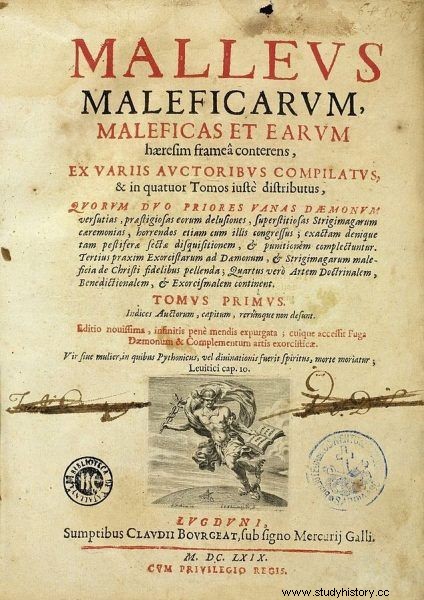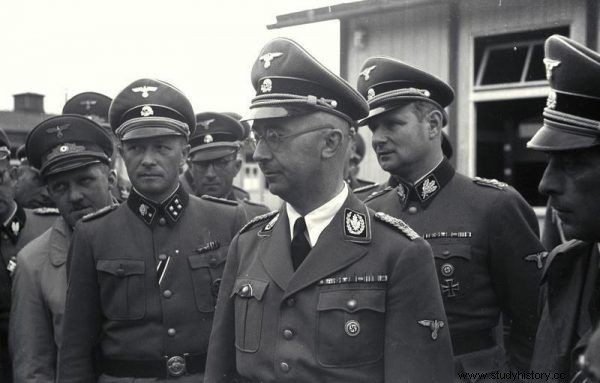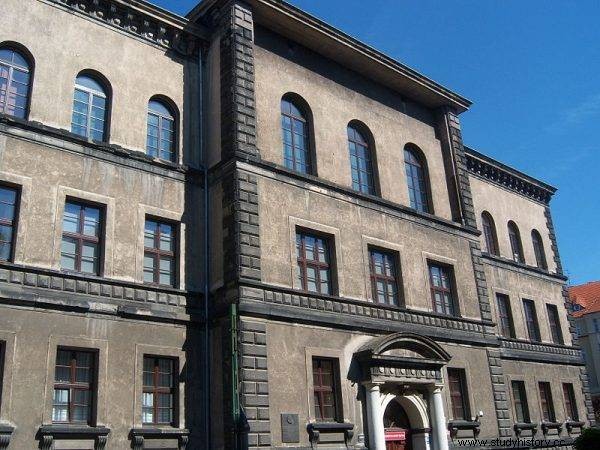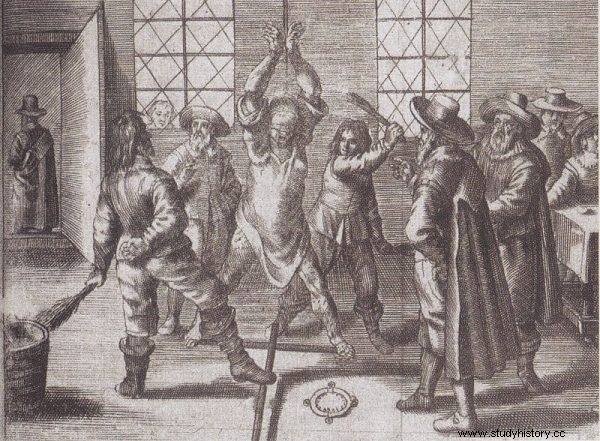In the State Archives in Poznań there is the so-called File of witchcraft trials. These files were compiled by a specially appointed SS unit in the years 1935–1944. Why were the Nazis interested in witchcraft trials just before and during World War II?
The said SS cell was called the H-Sonderkommando. The letter "H" refers to the German word Hexe , that is a witch (in the text I will use the abbreviation H.). The members of the team belonged to the VII Department of the Reich Security Main Office, dealing with the study of archives and historical evidence of the superiority of the Germanic race over the others (apart from that, the activities of this department were aimed at reproducing the original Old Germanic culture).
The witch hunt
The greatest havoc in the perception of beliefs in magic, divination and other magical practices was caused by the publication by two Dominicans - Heinrich Kramer and Jacob Sprenger - the book Malleus Maleficarum ( The Hammer of Witches ) in 1487.
From the 50s of the 15th century, the fight against practices considered heretical was regulated by the consent of Pope Nicholas V, and officially - by a bull issued by Innocent VIII in 1484 (previously this topic was not taken seriously, all stories were simply considered "fairy tales").

Hammer for witches, title page (photo:Wellcome Images, license CCA 4.0 I)
Unfortunately, item Witches Hammer it became even cult, and the greatest intensity of witchcraft trials took place in German countries . Women were most affected, because the text contained an "argument" about the alleged origin of the word femina (Latin woman). Etymologically, it would mean "less faith / little faith" - fe from fides (faith) and face from minus (less).
Statistically, more women accused of witchcraft than men stood in court (M. Pilaszek's calculations show the scale of this phenomenon in our country - 10.5% of convicted men and 89.5% of women in the years 1501–1794). So why did the Nazis become interested in the documentation of those events, which claimed the lives of thousands of people over several centuries?
Activities of H-Sonderkommando
The place of work of the head of the project, Dr. Rudolf Levin and eight people employed in this specific unit was the Reich Security Main Office located at the then Wilhelmstraße 102 (now Niederkirchnerstrasse).
The main task commissioned by the authorities was researching all available sources regarding witches and sorcerers, trials, methods of interrogation and information about the tools used for this purpose in the olden ages.
The obtained data were to be used to prove the existence of magic (Heinrich Himmler believed that the accused and sentenced to death, people who used magic practices were propagators of true Old Germanic traditions and were unfairly judged by the Church). In addition, the collected material was to strengthen and broaden the knowledge of the traditions and culture of the peoples inhabiting the territories of the then Third Reich.

Himmler visited the Mauthausen-Gusen camp twice. In the photo from the left:Ziereis, Himmler, Wolf in 1941.
In addition to theoretical knowledge, employees of the H-Sonderkommando also focused on the practices described in the files found during their queries; we are talking about descriptions of torture, tools for its execution and interrogation methods that could be used by the SS in the future .
File of witchcraft processes
The archival complex located in the State Archives in Poznań is a phenomenon on a global scale, and its full name is Central Security Office of the Reich Protection Relays Archive Department - cell for researching witchcraft trials .
At the end of the war, the files collected by the H-Sonderkommando were taken away and hidden (not for long, as already in 1946 they were found in Sława Śląska). The files were collected in a group consisting of 3,884 archival units. It covers as much as 15 m (a running meter is a unit of measurement for files arranged strictly next to each other in archives).

Place of storage - State Archives in Poznań
The introduction to the inventory was written by Dr. Krystyna Górska-Gołaska and she divided the team into eight parts:
- Files related to research organization, bibliographic lists and indexes
- The spells and processes directory
- Extracts from archival materials
- Photocopies of archival material
- Magazines and press clippings
- Illustrations
- Microfilms
- Original Archives
The material was developed by an employee of AP - Maciej Zdunek, who in the text File of witchcraft trials:history, content and possibilities of use cites statistics on the sources collected by the Nazis. The documentation shows that the research related to the inheritance of magic skills among the families of people convicted of practicing witchcraft was very popular with the SS .
With German meticulousness
H-Sonderkommando employees also collected general data, i.e. information about the people responsible for witch hunts, the areas where they took place, monasteries, nature, executioners, inquisitions and movements opposing the trials, about trying to understand the psychological aspects of the defendants' conduct (and even their mental state!), the condition of prisons and other locations serving as pre-trial detention centers. The main focus was the trial itself, the details of the torture and the trial .
The first part of the team can be used as an archival aid, it is necessary to pay attention to the fact carefully prepared bibliography and footnotes by H employees . (although, as M. Zdunek mentions, the list of literature and sources may be incomplete).

The main focus was on the trial itself, the details of torture and the trial.
The file is the heart of the team. It is a collection of special forms, on which, in dedicated fields (57), information was supplemented, e.g. on the personal data of the accused, attitude towards the Church, family and affinities, the type of crime committed, the trial, the sentence and the manner of executing the death penalty, in addition, the forms contain data on other people involved in the process itself (clergy and laity).
H. employees also completed the fields concerning the sources used and the full bibliography, and each form was signed with initials, signed with a date and prepared cards were arranged by place. More than 80% of the processes concerned the territories of Germany , however, you can find information on trials from other countries (including Poland, England, Iceland, Turkey, India, and even Mexico and the USA!). At the time of H.'s activity, the number of cards was 33,846. They were contained in 3670 folders (not all of them survived, however, 3622 have survived to this day).
Polish witchcraft trials in Files ...
The list prepared by M. Zdunek includes nine Polish towns (a total of 49 witchcraft trials). These are:Poznań, Bydgoszcz, Witkowo, Rydzyna, Vilnius, Wągrowiec and three unidentified towns (Kurow, Tschemesme, Kӓfelin).
34 cases concerning accusations of witchcraft are related to Wągrowiec. Interesting reasons for the arrest and the initiation of proceedings were, for example, red glowing eyes, the enchantment of oxen and ... a neighborhood quarrel. In addition, the forms contain rudimentary information about torture (even several times) and about a voluntary confession of guilt. The most popular form of execution was (surprisingly!) beheading (only in Wągrowiec), then burning at the stake and quartering. The information is scarce and there are, unfortunately, few references to the sources. Most of the data comes from the literature.
The archival group located in Poznań is extremely interesting, but it is worth remembering that it cannot be the basis for research on witchcraft processes. However, it can be a great help, after all, it contains many fantastic materials (from the point of view of a historian and archivist):photocopies of original documents and illustrations with trial scenes, torture tools, etc. It is also a testimony to the functioning of various ideas in a totalitarian state - strange assumptions and attempts to acquire supernatural knowledge.
